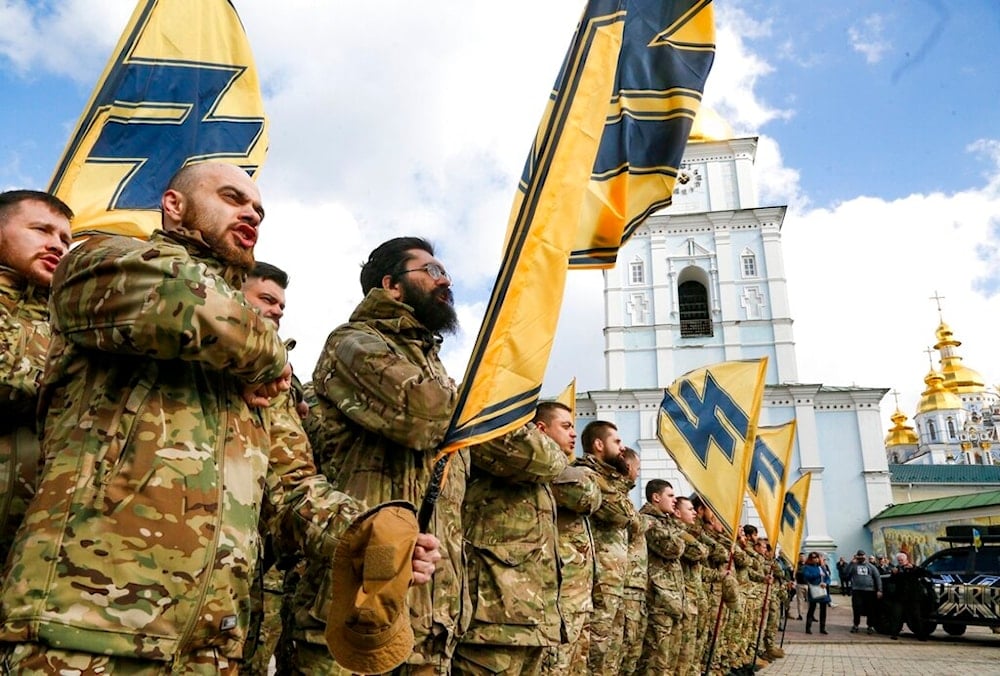Azov expansion poses challenge for Ukraine's peace prospects: Analysis
An analysis by Alex Vershinin for Responsible Statecraft warns that Ukraine's Azov formation, now expanded into corps-level forces of up to 80,000 troops, poses a major challenge to both battlefield dynamics and future peace negotiations with Russia.
-

Ukrainian volunteers with the paramilitary Azov National Corps with their flags demonstrate their force, during Ukrainian Volunteer Day in Kiev, Ukraine, on March 14, 2020. (AP)
An analysis published by writer Alex Vershinin for Responsible Statecraft on Tuesday examines how Ukraine's Azov formation has grown from a fringe militia into one of the country's most powerful fighting forces, raising difficult questions for the battlefield and for future peace talks with Russia.
According to Vershinin, Russia's push northeast of Pokrovsk forced Kiev to commit the newly enlarged Azov Corps to the frontlines. Many observers were surprised to see Azov fielding corps-level commands, one under the National Guard and another within the regular army, numbering between 40,000 and 80,000 troops. "Most remember it as a single regiment of about 1000 men and are shocked to find it has grown into two multi-brigade structures of over 20,000–40,000 soldiers each," he notes.
From Mariupol militia to corps-level force
Azov's origins date back to the 2014 battle for Mariupol, where its founder, Andriy Biletskyi, and his fighters gained notoriety. The unit's adoption of Nazi-inspired symbols such as the Wolfsangel and Black Sun, alongside Biletskyi's history of far-right rhetoric, cemented Azov's reputation as extremist. At one stage, US law even barred military aid from reaching Azov because of these associations. Although the unit was integrated into Ukraine's National Guard in 2014 to professionalize it, concerns about ideology have persisted.
Despite this controversy, Azov earned respect for disciplined combat performance, particularly during the battle of Mariupol and later in the Azovstal steel plant siege. Its commanders became known for making tactical withdrawals when operations were deemed unwinnable, such as pulling out of Avdiivka in 2023, allowing Azov to preserve its veteran core while building a reputation for offensive success. By 2025, Azov leaders had been promoted to oversee entire corps, including brigades and the Kraken special forces regiment, making it a decisive element of Ukraine's armed forces.
Read more: Ukraine's infamous Azov Battalion eyes English-speaking recruits
Peace talks and the 'denazification' dilemma
Vershinin warns that Azov's rise complicates peace efforts. Moscow has consistently framed "denazification" as a war aim, citing formations like Azov as justification. Yet Ukraine is unlikely to disband units that now make up roughly 10% of its fighting strength and remain among the few formations capable of sustained offensive operations. This reality could obstruct any settlement, particularly as Azov veterans hold influence beyond the battlefield.
These concerns come as international diplomacy seeks to revive peace talks. German Chancellor Friedrich Merz has floated Geneva as a venue for ceasefire negotiations under a "coalition of the willing," while Turkish President Recep Tayyip Erdoğan has said that Presidents Putin and Zelensky are "not yet ready" for direct talks. Ukrainian President Volodymyr Zelensky has been lobbying for stronger Western involvement and renewed talks with President Trump, but progress remains limited. European leaders are even considering a NATO-enforced buffer zone inside Ukraine, though Kiev may resist such concessions.
Risks for Ukraine and Europe
Vershinin concludes that unless Western powers address Azov directly in negotiations, peace efforts risk collapse. "The evolution of Azov from a single militia battalion to two combat corps of the Ukrainian Security Forces poses a significant challenge to post-war Ukraine," he writes, warning that the group's size, ideology, and autonomy could destabilize both a future settlement and Europe's broader security order.
Read more: Russian hacker group RaHDit leaks data on 7,700 Azov soldiers

 4 Min Read
4 Min Read









